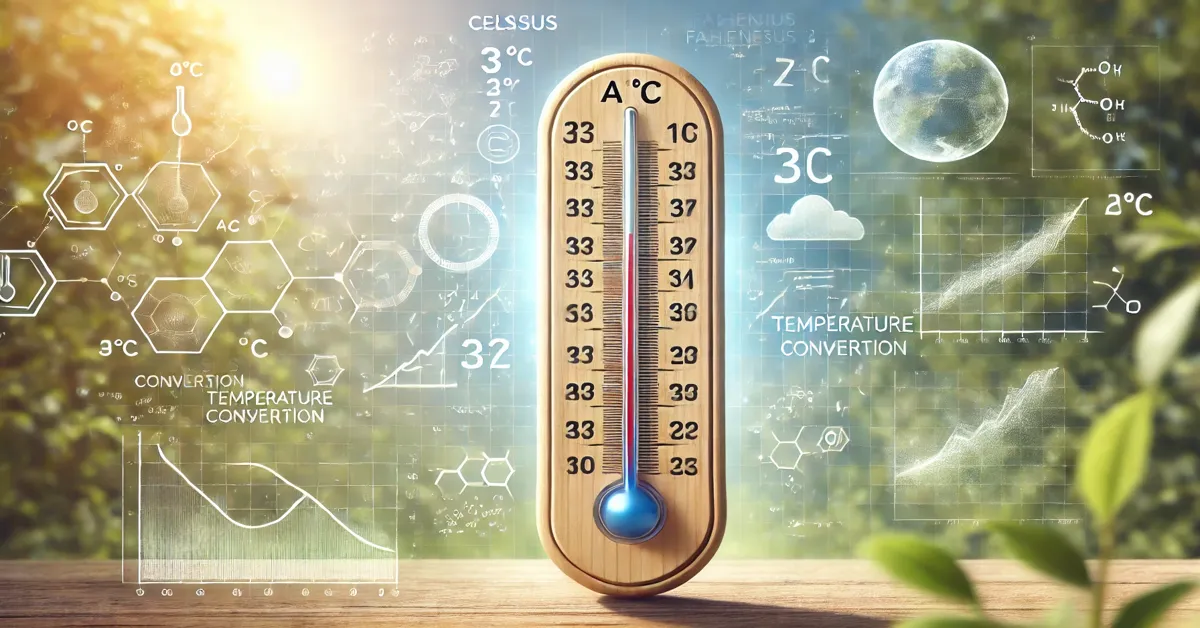Temperature conversion, such as converting 35 Celsius to Fahrenheit, is an essential skill in our interconnected world. Whether you’re traveling abroad, interpreting scientific data, or simply trying to understand a weather forecast from another country, knowing how to switch between temperature scales can make a significant difference in your comprehension. In this article, we’ll delve into the intricacies of Celsius and Fahrenheit, explore their histories, and understand their global applications while keeping our focus on the conversion of 35 Celsius to Fahrenheit.
The Basics of Temperature Measurement
Temperature is a measure of how hot or cold an object is, reflecting the average kinetic energy of the particles within it. Different regions and scientific disciplines have adopted various scales to measure temperature, the most common being Celsius and Fahrenheit. Let’s understand these scales in detail.
Celsius Scale
The Celsius scale, developed by Swedish astronomer Anders Celsius in 1742, is widely used across the globe. The scale is defined by two fixed points:
- 0 degrees Celsius (°C) is the freezing point of water.
- 100 degrees Celsius is the boiling point of water at standard atmospheric pressure.
This simplicity and its alignment with the metric system make it the preferred scale in most countries and scientific disciplines.
Fahrenheit Scale
The Fahrenheit scale, created by physicist Daniel Gabriel Fahrenheit in 1724, sets:
- 32 degrees Fahrenheit (°F) as the freezing point of water.
- 212 degrees Fahrenheit as the boiling point of water at standard atmospheric conditions.
The scale is primarily used in the United States, its territories, and some Caribbean nations.
The Formula for Conversion
To convert a temperature from Celsius to Fahrenheit, use the following formula:
This equation accounts for the differing zero points and scaling factors of the two systems. Using this formula, we can find the Fahrenheit equivalent of any Celsius temperature, including our example of 35 Celsius.
Step-by-Step Conversion of 35 Celsius to Fahrenheit
Let’s convert 35 Celsius to Fahrenheit using the formula:
- Multiply 35 by 9:
- Divide the result by 5:
- Add 32 to the result:
Thus, 35 Celsius is equivalent to 95 Fahrenheit.
Practical Implications of 35 Celsius (95 Fahrenheit)
A temperature of 35 Celsius is considered hot in many parts of the world. In Fahrenheit, this translates to 95, which also signals high temperatures. Understanding this equivalence is crucial for various reasons:
- Travel: If you’re visiting a country that uses Fahrenheit and the forecast predicts 95°F, you’ll recognize it as a warm day, equivalent to 35°C.
- Weather Forecasts: Many international travelers rely on weather forecasts to plan their activities. Knowing that 35 Celsius to Fahrenheit equals 95 helps bridge cultural and regional differences in interpreting weather.
- Health Precautions: At 35°C (95°F), it’s crucial to stay hydrated and avoid prolonged exposure to the sun, as heat-related illnesses can occur.
Historical Context of Temperature Scales
The development of temperature scales has been fundamental to advancements in science and industry. The Celsius and Fahrenheit scales were conceived to address different needs and contexts:
The Celsius Scale
Originally termed “centigrade” due to its 100-degree division, the Celsius scale was designed for simplicity. It gained widespread acceptance due to its alignment with the metric system, facilitating scientific calculations and measurements.
The Fahrenheit Scale
Fahrenheit’s scale offered finer graduations, making it ideal for meteorological applications in its early adoption stages. Its precision in representing everyday temperatures contributed to its continued use in the U.S.
Applications in Science and Industry
Accurate temperature conversion, including 35 Celsius to Fahrenheit, is vital in numerous fields:
Science and Research
Scientists often work with temperatures in Celsius, but international collaborations might necessitate conversions to Fahrenheit or Kelvin. For instance:
- A temperature of 35°C in an experimental setup might need documentation in Fahrenheit for American counterparts.
Environmental Monitoring
Environmental scientists use temperature data to study climate patterns. Converting between scales ensures consistency when sharing data globally. For instance, a report stating 35 Celsius to Fahrenheit helps American readers interpret findings accurately.
Industrial Applications
Industries such as food processing, manufacturing, and pharmaceuticals rely on precise temperature control. Machines might display readings in Celsius, but safety protocols in Fahrenheit necessitate accurate conversions.
Technological Tools for Conversion
In today’s digital age, converting 35 Celsius to Fahrenheit has become simpler with the help of technology. Some popular tools include:
- Online Calculators: Websites provide instant conversions.
- Mobile Apps: Apps like Unit Converter or Weather apps include temperature conversion functionalities.
- Smart Devices: Modern thermostats and gadgets often display temperatures in both scales.
Cultural and Regional Perspectives
Understanding temperature conversions goes beyond practicality—it fosters cultural awareness. While 35°C (95°F) signifies heat in most regions, cultural and regional adaptations might influence how people perceive and respond to such temperatures. This awareness enhances communication and planning in international contexts.
Conclusion
Converting 35 Celsius to Fahrenheit is more than a mathematical exercise; it’s a gateway to better understanding and navigating our globalized world. From interpreting weather forecasts to conducting scientific research, mastering temperature conversions bridges gaps between diverse systems and facilitates seamless communication. With the conversion of 35 Celsius equating to 95 Fahrenheit, you’re now equipped to handle one of the most commonly referenced temperature ranges with ease.
FAQs
1. What is the formula to convert Celsius to Fahrenheit? The formula is: °F = (°C × 9/5) + 32.
2. How do you convert 35 Celsius to Fahrenheit? Multiply 35 by 9, divide by 5, and add 32. The result is 95 Fahrenheit.
3. Why are there different temperature scales? Temperature scales were developed based on historical contexts and regional needs, leading to systems like Celsius and Fahrenheit.
4. Is 35 Celsius considered hot? Yes, 35°C (95°F) is considered warm to hot in most regions.
5. Why is Fahrenheit still used in the U.S.? Fahrenheit remains in use due to historical adoption and its finer gradation, which suits everyday temperature measurements.
6. What tools can help with temperature conversion? Online calculators, mobile apps, and smart devices provide quick and accurate temperature conversions.









